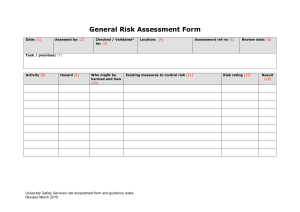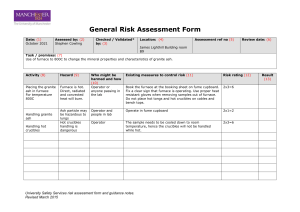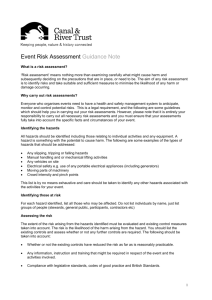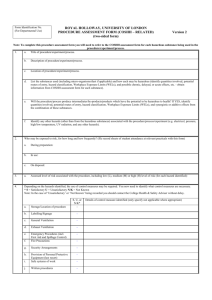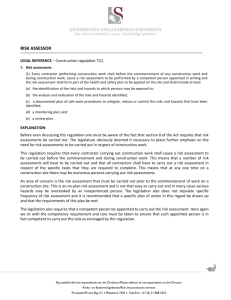Glue Dispenser - University of Manchester
advertisement
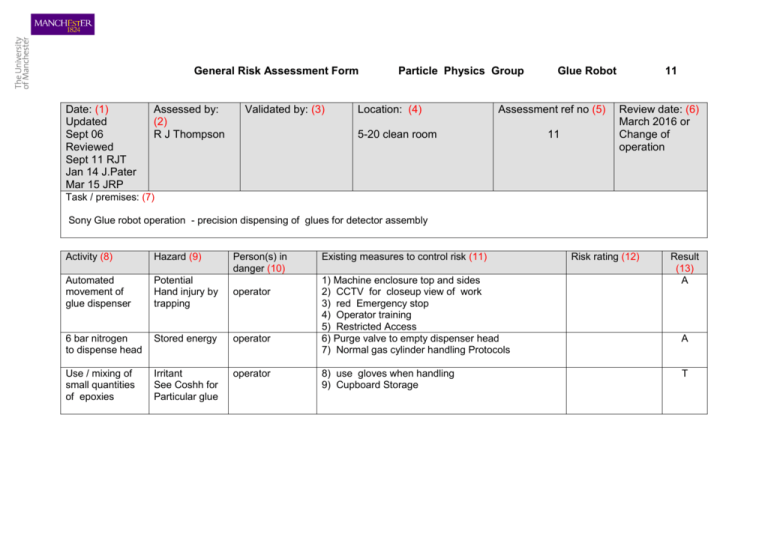
General Risk Assessment Form Date: (1) Updated Sept 06 Reviewed Sept 11 RJT Jan 14 J.Pater Mar 15 JRP Assessed by: (2) R J Thompson Validated by: (3) Particle Physics Group Location: (4) Glue Robot Assessment ref no (5) 5-20 clean room 11 11 Review date: (6) March 2016 or Change of operation Task / premises: (7) Sony Glue robot operation - precision dispensing of glues for detector assembly Activity (8) Hazard (9) Person(s) in danger (10) Automated movement of glue dispenser Potential Hand injury by trapping operator 6 bar nitrogen to dispense head Stored energy operator Use / mixing of small quantities of epoxies Irritant See Coshh for Particular glue operator Existing measures to control risk (11) 1) Machine enclosure top and sides 2) CCTV for closeup view of work 3) red Emergency stop 4) Operator training 5) Restricted Access 6) Purge valve to empty dispenser head 7) Normal gas cylinder handling Protocols 8) use gloves when handling 9) Cupboard Storage Risk rating (12) Result (13) A A T Notes to accompany General Risk Assessment Form This form is the one recommended by Health & Safety Services, and used on the University’s risk assessment training courses. It is strongly suggested that you use it for all new assessments, and when existing assessments are being substantially revised. However, its use is not compulsory. Providing the assessor addresses the same issues; alternative layouts may be used. (1) Date : Insert date that assessment form is completed. The assessment must be valid on that day, and subsequent days, unless circumstances change and amendments are necessary. (2) Assessed by : Insert the name and signature of the assessor. For assessments other than very simple ones, the assessor should have attended the University course on risk assessments (link to STDU) (3) Validated by : Insert the name and signature of someone in a position to validate that the assessment has correctly identified hazards and addressed the risks. This will normally be a line manager, supervisor, principal investigator, etc.. who should be competent to identify the hazards and assess the risks. This person should have attended the University’s risk assessment course, or equivalent. (4) Location : insert details of the exact location, ie building, floor, room or laboratory etc (5) Assessment ref no : use this to insert any local tracking references used by the school or administrative directorate (6) Review date : insert details of when the assessment will be reviewed as a matter of routine. This might be in 1 year’s time, at the end of a short programme of work, or longer period if risks are known to be stable. Note that any assessment must be reviewed if there are any significant changes – to the work activity, the vicinity, the people exposed to the risk, etc (7) Task / premises : insert a brief summary of the task, eg typical office activities such as filing, DSE work, lifting and moving small objects, use of misc electrical equipment. Or, research project [title] involving the use of typical laboratory hardware, including fume cupboards, hot plates, ovens, analysis equipment, flammable solvents, etc. (8) Activity : use the column to describe each separate activity covered by the assessment. The number of rows is unlimited, although how many are used for one assessment will depend on how the task / premises is sub-divided. For laboratory work, activities in one particular lab or for one particular project might include; use of gas cylinders, use of fume cupboard, use of computer or other electrical equipment, use of lab ovens, hot plates or heaters, use of substances hazardous to health, etc (9) Hazard : for each activity, list the hazards. Remember to look at hazards that are not immediately obvious. For example, use of a lathe will require identification of the machine hazards, but also identification of hazards associated with the use of cutting oils (dermatitis), poor lighting, slipping on oil leaks, etc. The same activity might well have several hazards associated with it. Assessment of simple chemical risks (eg use of cleaning chemicals in accordance with the instructions on the bottle) may be recorded here. More complex COSHH assessments eg for laboratory processes, should be recorded on the specific COSHH forms (link). University risk assessment form and guidance notes. Feb 05 (10) Persons in danger : insert everyone who might be affected by the activity. Remember those who are not immediately involved in the work, including cleaners, young persons on work experience, maintenance contractors, Estates personnel carrying out routine maintenance and other work. Remember also that the risks for different groups will vary. Eg someone who needs to repair a laser may need to expose the beam path more than users of the laser would do. (11) Existing measures to control the risk : list all measures that already mitigate the risk. Many of these will have been implemented for other reasons, but should nevertheless be recognised as means of controlling risk. For example, restricting access to laboratories or machine rooms for security reasons also controls the risk of unauthorised and unskilled access to dangerous equipment. A standard operating procedure or local rules (eg for work with ionising radiation, lasers or biological hazards) will often address risks. Some specific hazards may require detailed assessments in accordance with specific legislation (eg COSHH, DSEAR, manual handling, DSE work). Where this is the case, and a detailed assessment has already been done in another format, the master risk assessment can simply cross-reference to other documentation. For example, the activity might be use of a carcinogen, the hazard might be exposure to hazardous substances, the existing control measures might all be listed in a COSHH assessment. Controls might also include use of qualified and/or experienced staff who are competent to carry out certain tasks; an action plan might include training requirements for other people who will be carrying out those tasks. (12) Risk Rating : the simplest form of risk assessment is to rate the remaining risk as high, medium or low, depending on how likely the activity is to cause harm and how serious that harm might be. The risk is LOW - if it is most unlikely that harm would arise under the controlled conditions listed, and even if exposure occurred, the injury would be relatively slight. The risk is MEDIUM - if it is more likely that harm might actually occur and the outcome could be more serious (eg some time off work, or a minor physical injury. The risk is HIGH - if injury is likely to arise (eg there have been previous incidents, the situation looks like an accident waiting to happen) and that injury might be serious (broken bones, trip to the hospital, loss of consciousness), or even a fatality. Schools or administrative directorates may choose to use other rating systems. Typical amongst these are matrices (of 3x3, 4x4, 5x5 or even more complex) which require the assessor to select a numerical rating for both “likelihood that harm will arise” and “severity of that harm”. These may give a spurious sense of accuracy and reliability – none are based on quantitative methods. There are methods of estimating risk quantitatively, and these may be appropriate for complex design of load bearing structures and the like. Advice on methods of risk assessment is available from HSS. Whatever system of assessment is adopted, it is essential that the assessor has received suitable training and is familiar with the meaning of the terms (or numbers) used. (13) Result : this stage of assessment is often overlooked, but is probably the most important. Assigning a number or rating to a risk does not mean that the risk is necessarily adequately controlled. The options for this column are: T = trivial risk. Use for very low risk activities to show that you have correctly identified a hazard, but that in the particular circumstances, the risk is insignificant. University risk assessment form and guidance notes. Feb 05 A = adequately controlled, no further action necessary. If your control measures lead you to conclude that the risk is low, and that all legislative requirements have been met (and University policies complied with), then insert A in this column. N = not adequately controlled, actions required. Sometimes, particularly when setting up new procedures or adapting existing processes, the risk assessment might identify that the risk is high or medium when it is capable of being reduced by methods that are reasonably practicable. In these cases, an action plan is required. The plan should list the actions necessary, who they are to be carried out by, a date for completing the actions, and a signature box for the assessor to sign off that the action(s) has been satisfactorily completed. Some action plans will be complex documents; others may be one or two actions that can be completed with a short timescale. U = unable to decide. Further information required. Use this designation if the assessor is unable to complete any of the boxes, for any reason. Sometimes, additional information can be obtained readily (eg from equipment or chemicals suppliers, specialist University advisors) but sometimes detailed and prolonged enquiries might be required. Eg is someone is moving a research programme from a research establishment overseas where health and safety legislation is very different from that in the UK. For T and A results, the assessment is complete. For N or U results, more work is required before the assessment can be signed off. University risk assessment form and guidance notes. Feb 05
